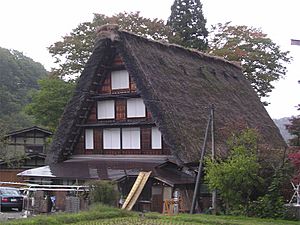Minka facts for kids
Minka (民家) are traditional Japanese houses. They are the homes where regular people like farmers, artisans, and merchants lived for hundreds of years. These special buildings are different from big palaces or temples. Minka show us how people lived and built homes in Japan long ago.
Contents
What are Minka?
Minka are a general term for all traditional Japanese buildings found in the countryside. They are not palaces or temples, but rather the homes and workplaces of everyday people. These buildings were made using local materials and building methods that were passed down through generations. They are a great example of how people adapted their homes to the environment and their way of life.
Different Kinds of Minka
There are several types or styles of minka, depending on where they were built and what they were used for. Each style has unique features.
Early Homes: Semi-Buried Huts
One of the earliest types of homes was the tate-ana jūkyo, which means "semi-buried hut." Imagine a small pit dug into the ground, with a roof built over it. These simple homes kept people warm in winter and cool in summer. They were common in ancient Japan before more advanced building techniques developed.
Wooden Houses with Special Roofs
Most minka are wooden houses with different kinds of roofs. The roof material often depended on what was available in the area.
- Thatch Roofs (kayabuki): Many minka have thick, sloped roofs made from dried grass or reeds. These roofs are called kayabuki. They are very good at keeping the house warm in winter and cool in summer. They also protect the house from rain and snow. Repairing these roofs is a big job, often done by many people working together.
- Wood Shingle Roofs (ishitori): Some minka used thin pieces of wood, called shingles, for their roofs. These roofs are known as ishitori. They were common in areas where wood was plentiful.
- Tile Roofs (kawarabuki): In some regions, especially in towns or for wealthier homes, minka had roofs made of clay tiles. These kawarabuki roofs were very durable and could last a long time.
Shops and Warehouses
Besides homes, minka also include traditional shops and warehouses.
- Warehouses (dozō, kura): These buildings were often made with thick, plastered walls to protect valuable goods from fire and thieves. They were very strong and sturdy.
Inside a Minka
Many minka had a large open space inside, often with a special hearth called an irori (囲炉裏). This was a sunken fireplace in the middle of the floor, used for cooking, heating, and lighting. Smoke from the irori would rise into the roof space, helping to preserve the thatch and keep insects away. Above the irori, a special hook called a jizai kagi (自在鉤) would hang, often with a fish-shaped counterbalance, used to hold pots over the fire.
Minka Today
Today, many minka are preserved as historical buildings or even used as guesthouses. They offer a unique look into Japan's past and the traditional way of life. Villages like those in Shirakawa-go and Gokayama are famous for their well-preserved minka, especially the Gasshō-zukuri style, which have very steep, triangular thatched roofs that look like hands clasped in prayer. These villages are even recognized as UNESCO World Heritage Sites.
Images for kids
See also
 In Spanish: Minka (Japón) para niños
In Spanish: Minka (Japón) para niños












